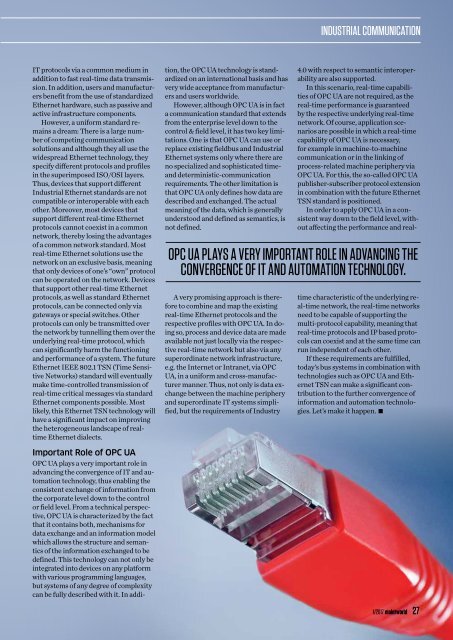Maintworld 1/2017
Create successful ePaper yourself
Turn your PDF publications into a flip-book with our unique Google optimized e-Paper software.
INDUSTRIAL COMMUNICATION<br />
IT protocols via a common medium in<br />
addition to fast real-time data transmission.<br />
In addition, users and manufacturers<br />
benefit from the use of standardized<br />
Ethernet hardware, such as passive and<br />
active infrastructure components.<br />
However, a uniform standard remains<br />
a dream: There is a large number<br />
of competing communication<br />
solutions and although they all use the<br />
widespread Ethernet technology, they<br />
specify different protocols and profiles<br />
in the superimposed ISO/OSI layers.<br />
Thus, devices that support different<br />
Industrial Ethernet standards are not<br />
compatible or interoperable with each<br />
other. Moreover, most devices that<br />
support different real-time Ethernet<br />
protocols cannot coexist in a common<br />
network, thereby losing the advantages<br />
of a common network standard. Most<br />
real-time Ethernet solutions use the<br />
network on an exclusive basis, meaning<br />
that only devices of one’s “own” protocol<br />
can be operated on the network. Devices<br />
that support other real-time Ethernet<br />
protocols, as well as standard Ethernet<br />
protocols, can be connected only via<br />
gateways or special switches. Other<br />
protocols can only be transmitted over<br />
the network by tunnelling them over the<br />
underlying real-time protocol, which<br />
can significantly harm the functioning<br />
and performance of a system. The future<br />
Ethernet IEEE 802.1 TSN (Time Sensitive<br />
Networks) standard will eventually<br />
make time-controlled transmission of<br />
real-time critical messages via standard<br />
Ethernet components possible. Most<br />
likely, this Ethernet TSN technology will<br />
have a significant impact on improving<br />
the heterogeneous landscape of realtime<br />
Ethernet dialects.<br />
Important Role of OPC UA<br />
OPC UA plays a very important role in<br />
advancing the convergence of IT and automation<br />
technology, thus enabling the<br />
consistent exchange of information from<br />
the corporate level down to the control<br />
or field level. From a technical perspective,<br />
OPC UA is characterized by the fact<br />
that it contains both, mechanisms for<br />
data exchange and an information model<br />
which allows the structure and semantics<br />
of the information exchanged to be<br />
defined. This technology can not only be<br />
integrated into devices on any platform<br />
with various programming languages,<br />
but systems of any degree of complexity<br />
can be fully described with it. In addition,<br />
the OPC UA technology is standardized<br />
on an international basis and has<br />
very wide acceptance from manufacturers<br />
and users worldwide.<br />
However, although OPC UA is in fact<br />
a communication standard that extends<br />
from the enterprise level down to the<br />
control & field level, it has two key limitations.<br />
One is that OPC UA can use or<br />
replace existing fieldbus and Industrial<br />
Ethernet systems only where there are<br />
no specialized and sophisticated timeand<br />
deterministic-communication<br />
requirements. The other limitation is<br />
that OPC UA only defines how data are<br />
described and exchanged. The actual<br />
meaning of the data, which is generally<br />
understood and defined as semantics, is<br />
not defined.<br />
A very promising approach is therefore<br />
to combine and map the existing<br />
real-time Ethernet protocols and the<br />
respective profiles with OPC UA. In doing<br />
so, process and device data are made<br />
available not just locally via the respective<br />
real-time network but also via any<br />
superordinate network infrastructure,<br />
e.g. the Internet or Intranet, via OPC<br />
UA, in a uniform and cross-manufacturer<br />
manner. Thus, not only is data exchange<br />
between the machine periphery<br />
and superordinate IT systems simplified,<br />
but the requirements of Industry<br />
OPC UA PLAYS A VERY IMPORTANT ROLE IN ADVANCING THE<br />
CONVERGENCE OF IT AND AUTOMATION TECHNOLOGY.<br />
4.0 with respect to semantic interoperability<br />
are also supported.<br />
In this scenario, real-time capabilities<br />
of OPC UA are not required, as the<br />
real-time performance is guaranteed<br />
by the respective underlying real-time<br />
network. Of course, application scenarios<br />
are possible in which a real-time<br />
capability of OPC UA is necessary,<br />
for example in machine-to-machine<br />
communication or in the linking of<br />
process-related machine periphery via<br />
OPC UA. For this, the so-called OPC UA<br />
publisher-subscriber protocol extension<br />
in combination with the future Ethernet<br />
TSN standard is positioned.<br />
In order to apply OPC UA in a consistent<br />
way down to the field level, without<br />
affecting the performance and realtime<br />
characteristic of the underlying real-time<br />
network, the real-time networks<br />
need to be capable of supporting the<br />
multi-protocol capability, meaning that<br />
real-time protocols and IP based protocols<br />
can coexist and at the same time can<br />
run independent of each other.<br />
If these requirements are fulfilled,<br />
today’s bus systems in combination with<br />
technologies such as OPC UA and Ethernet<br />
TSN can make a significant contribution<br />
to the further convergence of<br />
information and automation technologies.<br />
Let’s make it happen.<br />
1/<strong>2017</strong> maintworld 27

















